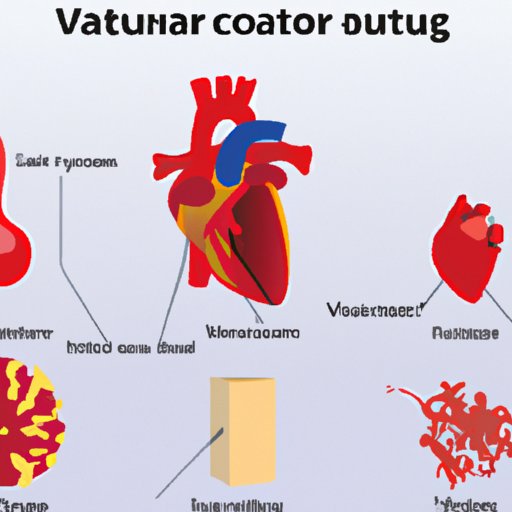Introduction
The heart is a powerful organ that plays a critical role in pumping oxygen-rich blood throughout the body. It does this by contracting and expanding to create pressure gradients that propel blood through its four chambers. In this article, we will explore how blood travels through the heart, examining the anatomy of the heart and the process of blood circulation, as well as the role of heart valves, hormones, aging, and congenital heart defects in regulating cardiac function.
Anatomy of the Heart: Exploring the Pathways of Blood Flow
The heart is divided into four chambers: the right atrium, left atrium, right ventricle, and left ventricle. The right side of the heart receives oxygen-depleted blood from the body and pumps it to the lungs via the pulmonary artery. The left side of the heart receives oxygen-rich blood from the lungs and pumps it to the rest of the body via the aorta. This process is known as the pulmonary and systemic circulations, respectively.

Explaining the Process of Blood Circulation
Blood flow begins with the coronary arteries, which supply oxygen-rich blood to the heart muscle. From there, the oxygen-rich blood enters the left atrium, passes through the left atrioventricular valve, and is pumped into the left ventricle. The left ventricle then contracts to generate pressure that propels the blood into the aorta, where it is distributed to the rest of the body. At the same time, oxygen-depleted blood from the body enters the right atrium, passes through the right atrioventricular valve, and is pumped into the right ventricle. The right ventricle then contracts to generate pressure that propels the blood into the pulmonary artery, where it is sent to the lungs to be reoxygenated.
Examining the Role of the Heart Valves in Cardiac Function
The heart valves are essential for regulating blood flow through the heart. The atrioventricular (AV) valves, located between the atria and the ventricles, prevent backflow of blood from the ventricles to the atria. The semilunar valves, located at the exit of each ventricle, also prevent backflow of blood and ensure that blood is propelled only in one direction. If any of these valves become dysfunctional, it can lead to a condition known as valvular heart disease, which can have serious consequences on cardiac function.

Exploring How Hormones Impact Blood Flow Through the Heart
Hormones play an important role in regulating blood flow through the heart. Epinephrine and norepinephrine are two hormones released by the adrenal glands in response to stress or physical activity. These hormones cause an increase in heart rate and blood pressure, which increases the flow of blood to the muscles. In addition, hormones such as angiotensin II and aldosterone help to regulate blood pressure and fluid balance in the body.
Examining the Effects of Aging on Cardiac Function
As we age, our hearts undergo structural changes that can affect their ability to pump blood efficiently. Studies have shown that aging can lead to a decrease in heart size, a decrease in the elasticity of the heart walls, and an increase in arterial stiffness. These changes can lead to a decrease in cardiac output and an increase in the risk of developing cardiovascular diseases such as hypertension and stroke.

Understanding Congenital Heart Defects and Their Impact on Blood Flow
Congenital heart defects are abnormalities present at birth that affect the structure or function of the heart. These defects can range from mild to severe and can have significant impacts on blood flow. Common symptoms associated with congenital heart defects include shortness of breath, fatigue, and cyanosis. Treatment options vary depending on the type and severity of the defect but may include medications, surgery, or lifestyle modifications.
Conclusion
In conclusion, understanding how blood travels through the heart is essential for maintaining good cardiovascular health. The heart pumps oxygen-rich blood throughout the body via the pulmonary and systemic circulations, and the heart valves play an important role in regulating this flow. In addition, hormones, aging, and congenital heart defects all impact blood flow through the heart, and these factors should be taken into account when assessing cardiac function.
(Note: Is this article not meeting your expectations? Do you have knowledge or insights to share? Unlock new opportunities and expand your reach by joining our authors team. Click Registration to join us and share your expertise with our readers.)
